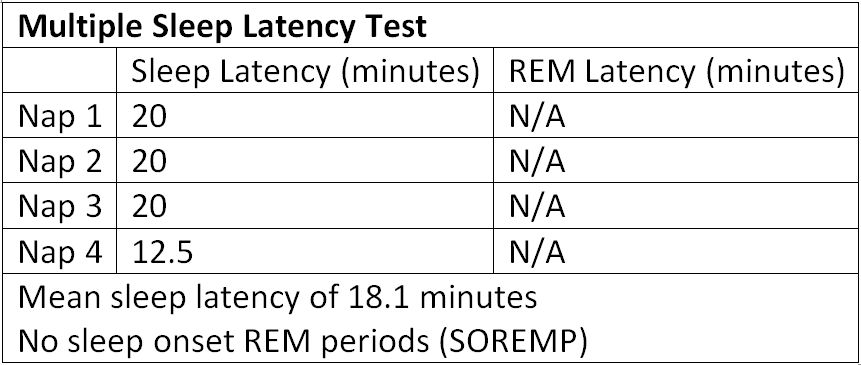Reviewed By Sleep and Respiratory Neurobiology Assembly
Submitted by
Tirsa M. Ferrer Marrero, MD
Fellow
Section of Pulmonary, Critical Care, Sleep, and Allergy
University of Illinois at Chicago
Chicago, Illinois
Bharati Prasad, MD, MS
Assistant Professor
Section of Pulmonary, Critical Care, Sleep, and Allergy
University of Illinois at Chicago
Chicago, Illinois
Submit your comments to the author(s).
History
A 39 year old man presented with insidious onset of excessive daytime sleepiness; EDS over 10 years (Epworth Sleepiness Scale score 16) and sudden onset of “passing out spells” occurring several times daily for 5 years. One spell was witnessed by consulting neurologist, resulting in referral of the patient to our sleep center. The passing out was described as symmetrical weakness of his arms and legs, without loss of consciousness. He stated he had learnt to support himself against a wall or sit down to prevent falls. These episodes lasted a few minutes and no specific triggers were identified. These symptoms resulted in loss of employment 2 years prior to presentation. Other symptoms included habitual snoring, difficulty maintaining sleep at night, frequent hypnogogic and hypnopompic visual hallucinations, and sleep paralysis. Self-reported nightly sleep duration was approximately 7 hours with a regular sleep wake schedule (11 PM to 6 AM). No past medical history, medication use, drug use, shift work, or family history of sleep disorders were reported. Alcohol use was described as social (3-6 drinks over the weekend).
Physical Exam
Body mass index (BMI) was 29, Mallampati was 3, and neck circumference was 15.5 inches. Neurological exam and previous neurological evaluation with EEG and MRI brain were normal. A baseline polysomnography followed by a 4-nap Multiple Sleep Latency Test (MSLT) the following day was performed (patient refused the fifth nap).
Image: Hypnogram of baseline polysomnography (PSG)
PSG summary:
- Sleep Efficiency: 36% (Total Sleep Time; TST of 182 minutes)
- Sleep Latency: 27 minutes
- REM Latency: 127 minutes
- Apnea hypopnea index (AHI) of 10/hour, nadir oxygen saturation of 89%, and PLMS-index of 0/hour.

References
- Thijs RD, Bloem BR, van Dijk JG. Falls, faints, fits and funny turns. J Neurol. 2009;256(2):155-67.
- Littner MR, Kushida C, Wise M, Davila DG, Morgenthaler T, Lee-Chiong T, Hirshkowitz M, Daniel LL, Bailey D, Berry RB, Kapen S, Kramer M; Standards of Practice Committee of the American Academy of Sleep Medicine. Practice parameters for clinical use of the multiple sleep latency test and the maintenance of wakefulness test. SLEEP. 2005;28(1):113-21.
- Weaver TE, Mancini C, Maislin G, Cater J, Staley B, Landis JR, Ferguson KA, George CF, Schulman DA, Greenberg H, Rapoport DM, Walsleben JA, Lee-Chiong T, Gurubhagavatula I, Kuna ST. Continuous positive airway pressure treatment of sleepy patients with milder obstructive sleep apnea: results of the CPAP Apnea Trial North American Program (CATNAP) randomized clinical trial. Am J Respir Crit Care Med. 2012;186(7):677-83.
- Kushida CA; Nichols DA; Holmes TH; Quan SF; Walsh JK; Gottlieb DJ; Simon RD; Guilleminault C; White DP; Goodwin JL; Schweitzer PK; Leary EB; Hyde PR; Hirshkowitz M; Green S; McEvoy LK; Chan C; Gevins A; Kay GG; Bloch DA; Crabtree T; Demen WC. Effects of continuous positive airway pressure on neurocognitive function in obstructive sleep apnea patients: the Apnea Positive Pressure Long-term Efficacy Study (APPLES). SLEEP 2012;35(12):1593-1602.
- Weaver TE, Chasens ER, Arora S. Modafinil improves functional outcomes in patients with residual excessive sleepiness associated with CPAP treatment. J Clin Sleep Med. 2009;5(6):499-505.
- Ohayon MM, Bader G. Prevalence and correlates of insomnia in the Swedish population aged 19-75 years. Sleep Med. 2010;11(10):980-6.
- Overeem S, Van Nues SJ, Van der Zande WL, Donjacour CE, Van Mierlo P, Lammers GJ. The clinical features of cataplexy: a questionnaire study in narcolepsy patients with and without hypocretin-1 deficiency. Sleep Med. 2011;12(1):12-8.
- Mahlios J, De la Herrán-Arita AK, Mignot E. The autoimmune basis of narcolepsy. Curr Opin Neurobiol. 2013: S0959-4388(13)00102-5.
- Hong SC, Lin L, Jeong JH, et al. A study of the diagnostic utility of HLA typing, CSF hypocretin-1 measurements, and MSLT testing for the diagnosis of narcolepsy in 163 Korean patients with unexplained excessive daytime sleepiness. SLEEP. 2006;29(11):1429–1438.
- Peacock J, Benca, R. Narcolepsy: Clinical features, co- morbidities and treatment. Indian J Med Res. 2010;131:338-349.
- McDaid C, Griffin S, Weatherly H, Durée K, van der Burgt M, van Hout S, Akers J, Davies RJ, Sculpher M, Westwood M. Continuous positive airway pressure devices for the treatment of obstructive sleep apnoea-hypopnoea syndrome: a systematic review and economic analysis. Health Technol Assess. 2009; 13(4):iii-iv, xi-xiv, 1-119, 143-274.
- Mignot E, Lammers GJ, Ripley B, Okun M, Nevsimalova S, Overeem S, Vankova J, Black J, Harsh J, Bassetti C, Schrader H, Nishino S. The role of cerebrospinal fluid hypocretin measurement in the diagnosis of narcolepsy and other hypersomnias. Archives of Neurology. 2002;59: 1553-1562.
- Bourgin P, Zeitzer JM, Mignot E. CSF hypocretin-1 assessment in sleep and neurological disorders. Lancet Neurol. 2008;7(7):649-62.
- Nevsimalova S, Pisko J, Buskova J, Kemlink D, Prihodova I, Sonka K, Skibova J. Narcolepsy: clinical differences and association with other sleep disorders in different age groups. J Neurol. 2012. [Epub ahead of print]
- Cao M, Guilleminault C. Hypocretin and its emerging role as a target for treatment of sleep disorders. Curr Neurol Neurosci Rep. 2011;11:227-34.
- Han F, Mignot E, Wei YC, Dong SX, Li J, Lin L, An P, Wang LH, Wang JS, He MZ, Gao HY, Li M, Gao ZC, Strohl KP. Ventilatory chemoresponsiveness, narcolepsy-cataplexy and human leukocyte antigen DQB1*0602 status. Eur Respir J. 2010 ;36:577-83.
- Wise MS, Arand DL, Auger RR, Brooks SN, Watson NF; American Academy of Sleep Medicine. Treatment of narcolepsy and other hypersomnias of central origin. SLEEP. 2007;30:1712-27.
- Mignot EJ. A practical guide to the therapy of narcolepsy and hypersomnia syndromes. Neurotherapeutics. 2012;9:739-52.
- Alshaikh MK, Tricco AC, Tashkandi M, Mamdani M, Straus SE, BaHammam AS. Sodium oxybate for narcolepsy with cataplexy: systematic review and meta-analysis. J Clin Sleep Med. 2012; 8:451-8.



